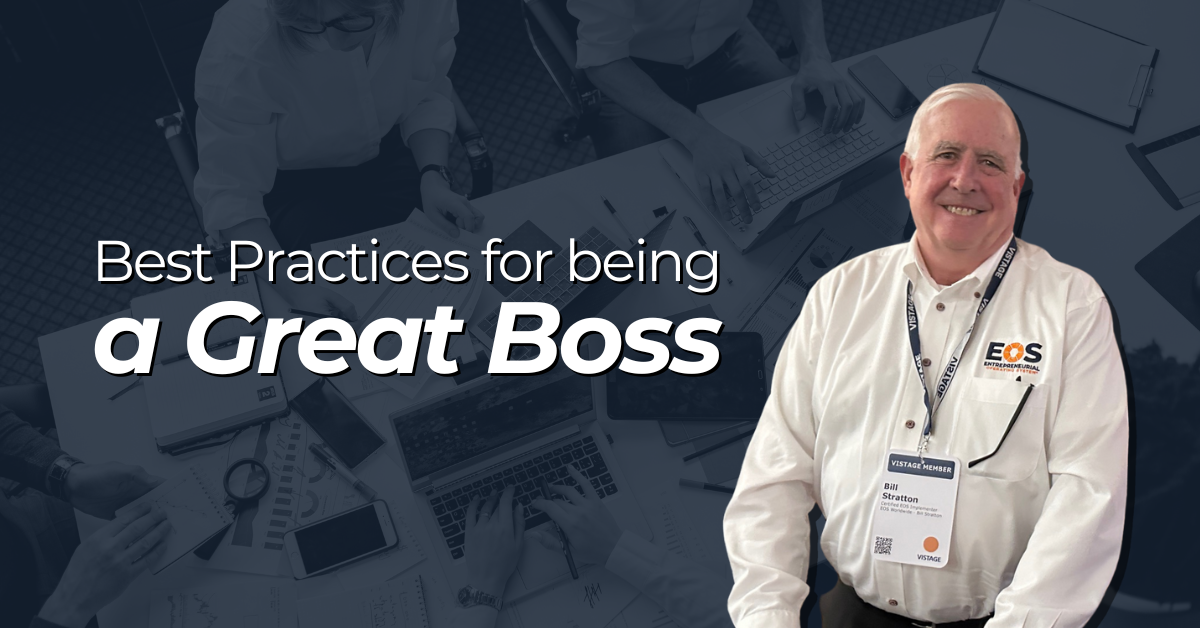There’s No “Right” Way to Be a Leader, But You Need Two Essential Qualities to Do It Well
In their book, “What It Takes to Be a Great Boss,” Gino Wickman and René Boor help leaders, managers, and supervisors leverage the People component of the EOS® Model to create a productive and motivated workforce.
Often, I find that leaders worry too much about whether their leadership and management styles are up to par when those things don’t matter all that much. Whether your style is “tough and tell it like it is” or “subtle and soft-spoken,” you can be a remarkable boss if you:
- Genuinely care about your people.
- Truly want to be a great leader and manager.
These characteristics are non-negotiable, and as long as you possess them, you have the makings of a great leader. And EOS concepts and tools — like the LMA™ formula: Leadership + Management = Accountability — can help get you there.
The Differences Between Leadership and Management
Understanding that leadership and management are two different things is also important.
In a nutshell, leadership is about providing direction, while management is about setting expectations.
A comparison of their nuances looks like this:
- Leadership = “On”; Management = “In”
- Leadership = Clear Direction; Management = Expectations
- Leadership = Creating the Opening; Management = Communication
- Leadership = Thinking; Management = Doing (Executing)
As I mentioned earlier, your will to be an exemplary boss and help employees achieve their potential provides a firm foundation for success. Regardless of personal style, anyone who leads or manages people can earn their team’s confidence, empower team members to perform exceptional work, instill a sense of community, and motivate employees to do their best by following the leadership and management practices below.
5 Leadership Practices
- Provide clear direction – Define and share your company vision and detail the roles and responsibilities within your organization. The EOS Vision Traction Organizer™ tool and the EOS Accountability Chart™ will help you.
- Provide people with the resources they need to do their jobs – Whether training, technology, information, coaching, or your time, you must give employees what they need to fulfill their responsibilities and meet expectations.
- Let go of the vine – Effective leadership isn’t about taking control of everything; it’s about delegating responsibilities to others who can capably handle them. Doing so frees you to maximize the value you provide to your organization.
- Act with the greater good in mind – Do your words, actions, and behaviors align with your organization’s core values? As a leader, you set an example for others to follow. If you think no one is watching, think again!
- Take a Clarity Break™ – Leaders can often become overwhelmed or too busy with immediate day-to-day concerns to think about the future. But it’s essential to sometimes separate yourself from the present issues of working “in” the business to work “on” the business. Get out of the office and go where you can think without interruption. Taking daily, weekly, or monthly Clarity Breaks provides time to reflect on your goals, creatively problem-solve, strategize, and build your self-confidence as a leader.
5 Management Practices
- Set clear expectations – Ensure your direct reports understand their role and responsibilities and how they relate to your organization’s core values. Rocks (90-day priorities) and measurables will help them track their performance.
- Communicate effectively – Don’t assume you know what’s on a team member’s mind—ask! Also, encourage your direct reports to ask you questions if they’re unsure about what you expect from them. One technique to facilitate communication is to ask the individual to name one positive and one negative emotion they’re feeling in the moment—and then share yours. This will help build trust and understanding of one another.
- Have the Right Meeting Pulse™ – Your meeting routine should keep all circles connected, i.e., it should ensure your management team communicates well and knows what is on track and what is not. A weekly Level 10 Meeting™ is one of the most effective EOS tools for achieving this.
- Have Quarterly Conversations™ – I recommend that managers schedule an informal, one-on-one conversation with each of their direct reports every 90 days. These meetings are NOT performance reviews and do not go into the HR files. They are opportunities for you to learn about any issues or challenges your direct reports are experiencing, help them identify resolutions, and provide guidance and support. In addition to building a stronger bond between you and your employees, Quarterly Conversations also help eliminate undesirable surprises during performance reviews.
- Reward and recognize team members – Provide feedback—whether positive praise or constructive criticism—within 24 hours of an activity or incident when the details are still fresh in the individual’s memory. When an individual accomplishes something praiseworthy, acknowledge it publicly, but when delivering negative feedback, do so privately. Remember, you are your employees’ boss, not their buddy.
Ready to Be a Great Boss?
While there is no right way to be a leader or manager, there are tried-and-true actions to keep employees engaged, retain top talent, and cultivate future leaders. Schedule a call to discuss how I can help you be the boss you want to be.
Sources and References:
“How to Be a Great Boss,” by Gino Wickman and René Boor
